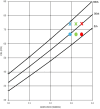The Impact of Dating Twin Pregnancy by the Larger, Smaller or Mean Twin Crown-Rump Length: A Retrospective Cohort Study
- PMID: 39780700
- PMCID: PMC11879912
- DOI: 10.1111/1471-0528.18065
The Impact of Dating Twin Pregnancy by the Larger, Smaller or Mean Twin Crown-Rump Length: A Retrospective Cohort Study
Abstract
Objective: To evaluate the impact of twin dating by ultrasound-measured crown-rump length (CRL) of the larger (CRL-L), smaller (CRL-S) or mean twin measurement (CRL-M) on the rates of preterm birth (PTB) and detection of small for gestational age (SGA) births.
Design: A retrospective cohort study.
Setting: A tertiary fetal medicine centre (London, UK).
Population or sample: All twin pregnancies between 1998 and 2023 who underwent first trimester CRL ultrasound assessment and fetal growth assessment.
Methods: Data collection included CRL measurement, estimated fetal weight (EFW), pregnancy outcome and birthweight (BW) for each twin. Pregnancies were retrospectively re-dated by CRL-S, CRL-L and CRL-M.
Main outcome measures: SGA < 10th centile and extreme PTB rates (< 28 weeks).
Results: In the 1129 twin pregnancies, median CRL-S was 61 mm (interquartile range [IQR]: 56.0-66.0) and CRL-L was 63 mm (IQR: 58.4-68.9) with a mean discordance of 4.0%. Prenatal SGA diagnosis occurred in 19.8% and 23.1% of smaller twins when dated by CRL-S and CRL-L, respectively. When pregnancies were dated by CRL-M versus CRL-S or CRL-L, there was no difference in prenatal SGA diagnosis (p = 0.275 and p = 0.419); SGA at birth (p = 0.132 and p = 0.325); or extreme PTB (p = > 0.999 and p = 0.765 respectively).
Conclusions: Dating by the smaller, larger or mean twin CRL does not significantly alter rates of extreme preterm birth, SGA detection or SGA birth. Dating by the mean twin CRL reduces stigmatisation of the smaller twin and retains the utility of accurate gestational age assessment without impacting clinical outcomes.
Keywords: crown‐rump length; gestational age; perinatal mortality; pregnancy dating; preterm birth; small for gestational age; twins.
© 2025 The Author(s). BJOG: An International Journal of Obstetrics and Gynaecology published by John Wiley & Sons Ltd.
Conflict of interest statement
The authors declare no conflicts of interest.
Figures



Similar articles
-
Intertwin discordance in fetal size at 11-13 weeks' gestation and pregnancy outcome.Ultrasound Obstet Gynecol. 2020 Feb;55(2):189-197. doi: 10.1002/uog.21923. Ultrasound Obstet Gynecol. 2020. PMID: 31710737
-
Crown-rump length discordance and adverse perinatal outcome in twins: analysis of the Southwest Thames Obstetric Research Collaborative (STORK) multiple pregnancy cohort.Ultrasound Obstet Gynecol. 2013 Jun;41(6):621-6. doi: 10.1002/uog.12430. Epub 2013 May 3. Ultrasound Obstet Gynecol. 2013. PMID: 23408454
-
Crown-rump length discordance in the first trimester: a predictor of adverse outcome in twin pregnancies?Ultrasound Obstet Gynecol. 2014 Mar;43(3):277-83. doi: 10.1002/uog.12534. Epub 2014 Feb 12. Ultrasound Obstet Gynecol. 2014. PMID: 23754823
-
Intertwin estimated fetal weight or crown rump length discordance and adverse perinatal outcome.J Perinat Med. 2016 Oct 1;44(8):863-869. doi: 10.1515/jpm-2015-0242. J Perinat Med. 2016. PMID: 26540215 Review.
-
Small babies, big risks: global estimates of prevalence and mortality for vulnerable newborns to accelerate change and improve counting.Lancet. 2023 May 20;401(10389):1707-1719. doi: 10.1016/S0140-6736(23)00522-6. Epub 2023 May 8. Lancet. 2023. PMID: 37167989 Review.
References
MeSH terms
LinkOut - more resources
Full Text Sources
Medical

